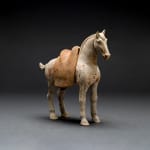Tang Sculpture of a Horse with Removable Saddle, 618 CE - 906 CE
Painted Terracotta
height 30.5 cm
height 12 in
height 12 in
H.942
The great influence of the horse throughout the history of China cannot be underestimated. In fact, the ancient unification of the Chinese Empire was due in large part to the...
The great influence of the horse throughout the history of China cannot be underestimated. In fact, the ancient unification of the Chinese Empire was due in large part to the horse. Their rapid mobility allowed for quick communication between far away provinces. Likewise, the military role of horses aided in the conquest and submission of distant lands. The need to import stronger, faster steeds from Central Asia (as opposed to the native Mongol pony) led to the creation of the Silk Road. The importance of the horse in the history and culture of China can be viewed, in part, through the artistic legacy of this great civilization. In sculpture, painting, and literature, horses were glorified and revered, believed to be relatives of dragons, a theory reflecting their sacred status within society. During the Tang Dynasty, the adoration of the horse can be seen through their burial art. Horse models excavated from mausoleums of the period are among the most splendid and easily recognizable works of Chinese art. This impressive sculpture of a horse still retains much of its original white pigment in tact. Traces of red are also visible inside the nose and on the mouth. However, even more impressive, is the removable saddle that graces his back. Painted orange, this incised saddle may have once supported a rider who is now lost to us. This gorgeous sculpture is a testament to the admiration and adoration the Chinese had for this marvelous creatures. Although they were an integral part in the expansion and defense of the empire, they were equally regarded for their beauty and grace as revealed by this sculpture.



